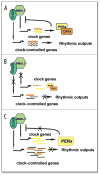Circadian clock genes as modulators of sensitivity to genotoxic stress
- PMID: 15917646
- PMCID: PMC3774065
- DOI: 10.4161/cc.4.7.1792
Circadian clock genes as modulators of sensitivity to genotoxic stress
Abstract
A broad variety of organisms display circadian rhythms (i.e., oscillations with 24-hr periodicities) in many aspects of their behavior, physiology and metabolism. These rhythms are under genetic control and are generated endogenously at the cellular level. In mammals, the core molecular mechanism of the oscillator consists of two transcriptional activators, CLOCK and BMAL1, and their transcriptional targets, CRYPTOCHROMES (CRYS) and PERIODS (PERS). The CRY and PER proteins function as negative regulators of CLOCK/BMAL1 activity, thus forming the major circadian autoregulatory feedback loop. It is believed that the circadian clock system regulates daily variations in output physiology and metabolism through periodic activation/repression of the set of clock-controlled genes that are involved in various metabolic pathways. Importantly, circadian-controlled pathways include those that determine in vivo responses to genotoxic stress. By using circadian mutant mice deficient in different components of the molecular clock system, we have established genetic models that correlate with the two opposite extremes of circadian cycle as reflected by the activity of the CLOCK/BMAL1 transactivation complex. Comparison of the in vivo responses of these mutants to the chemotherapeutic drug, cyclophosphamide (CY), has established a direct correlation between drug toxicity and the functional status of the CLOCK/BMAL1 transcriptional complex. We have also demonstrated that CLOCK/BMAL1 modulates sensitivity to drug-induced toxicity by controlling B cell responses to active CY metabolites. These results suggest that the sensitivity of cells to genotoxic stress induced by anticancer therapy may be modulated by CLOCK/BMAL1 transcriptional activity. Further elucidation of the molecular mechanisms of circadian control as well as identification of specific pharmacological modulators of CLOCK/BMAL1 activity are likely to lead to the development of new anti-cancer treatment schedules with increased therapeutic index and reduced morbidity.
Figures


Similar articles
-
Post-translational regulation of circadian transcriptional CLOCK(NPAS2)/BMAL1 complex by CRYPTOCHROMES.Cell Cycle. 2006 Apr;5(8):890-5. doi: 10.4161/cc.5.8.2684. Epub 2006 Apr 17. Cell Cycle. 2006. PMID: 16628007
-
Dual role of the CLOCK/BMAL1 circadian complex in transcriptional regulation.FASEB J. 2006 Mar;20(3):530-2. doi: 10.1096/fj.05-5321fje. Epub 2006 Jan 25. FASEB J. 2006. PMID: 16507766
-
Genetics and neurobiology of circadian clocks in mammals.Cold Spring Harb Symp Quant Biol. 2007;72:251-259. doi: 10.1101/sqb.2007.72.052. Cold Spring Harb Symp Quant Biol. 2007. PMID: 18419282 Free PMC article. Review.
-
Interactivating feedback loops within the mammalian clock: BMAL1 is negatively autoregulated and upregulated by CRY1, CRY2, and PER2.Biochem Biophys Res Commun. 2002 Jan 25;290(3):933-41. doi: 10.1006/bbrc.2001.6300. Biochem Biophys Res Commun. 2002. PMID: 11798163
-
Protein interaction networks of the mammalian core clock proteins.Adv Protein Chem Struct Biol. 2022;131:207-233. doi: 10.1016/bs.apcsb.2022.04.001. Epub 2022 May 20. Adv Protein Chem Struct Biol. 2022. PMID: 35871891 Review.
Cited by
-
Chronotoxici-Plate Containing Droplet-Engineered Rhythmic Liver Organoids for Drug Toxicity Evaluation.Adv Sci (Weinh). 2024 Jul;11(28):e2305925. doi: 10.1002/advs.202305925. Epub 2024 May 8. Adv Sci (Weinh). 2024. PMID: 38720476 Free PMC article.
-
Chronomodulated Administration of Chemotherapy in Advanced Colorectal Cancer: A Systematic Review and Meta-Analysis.Cureus. 2023 Mar 22;15(3):e36522. doi: 10.7759/cureus.36522. eCollection 2023 Mar. Cureus. 2023. PMID: 37090313 Free PMC article. Review.
-
Potential Role of the Circadian Clock in the Regulation of Cancer Stem Cells and Cancer Therapy.Int J Mol Sci. 2022 Nov 16;23(22):14181. doi: 10.3390/ijms232214181. Int J Mol Sci. 2022. PMID: 36430659 Free PMC article. Review.
-
Circadian Rhythms, Disease and Chronotherapy.J Biol Rhythms. 2021 Dec;36(6):503-531. doi: 10.1177/07487304211044301. Epub 2021 Sep 22. J Biol Rhythms. 2021. PMID: 34547953 Free PMC article. Review.
-
Does timing matter in radiotherapy of hepatocellular carcinoma? An experimental study in mice.Cancer Med. 2021 Nov;10(21):7712-7725. doi: 10.1002/cam4.4277. Epub 2021 Sep 20. Cancer Med. 2021. PMID: 34545699 Free PMC article.
References
-
- Slamon DJ, Leyland-Jones B, Shak S, Fuchs H, Paton V, Bajamonde A, Fleming T, Eiermann W, Wolter J, Pegram M, Baselga J, Norton L. Use of chemotherapy plus a monoclonal antibody against HER2 for metastatic breast cancer that overexpresses HER2. N Engl J Med. 2001;344:783–92. - PubMed
-
- McLeod DG. Hormonal therapy: Historical perspective to future directions. Urology. 2003;61:3–7. - PubMed
-
- Jones KL, Buzdar AU. A review of adjuvant hormonal therapy in breast cancer. Endocr Relat Cancer. 2004;11:391–406. - PubMed
-
- Thomas H, Coley HM. Overcoming multidrug resistance in cancer: An update on the clinical strategy of inhibiting p-glycoprotein. Cancer Control. 2003;10:159–65. - PubMed
-
- Collis SJ, DeWeese TL. Enhanced radiation response through directed molecular targeting approaches. Cancer Metastasis Rev. 2004;23:277–92. - PubMed
Publication types
MeSH terms
Grants and funding
LinkOut - more resources
Full Text Sources
